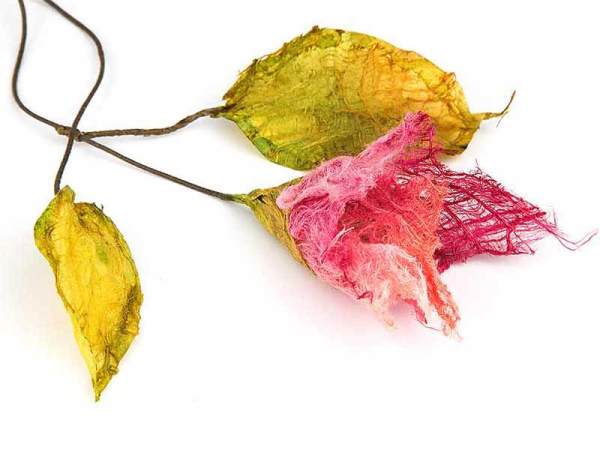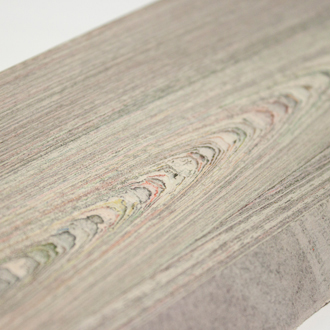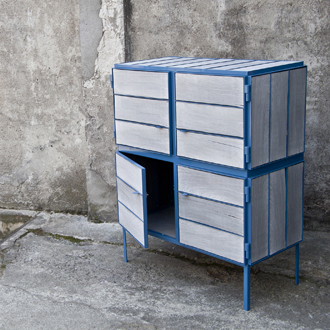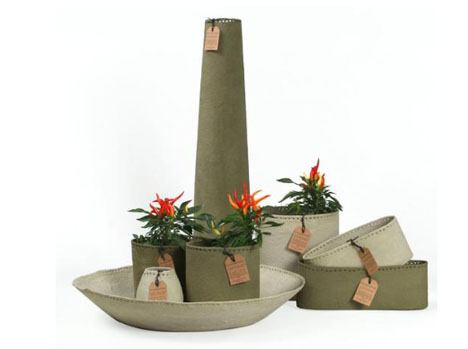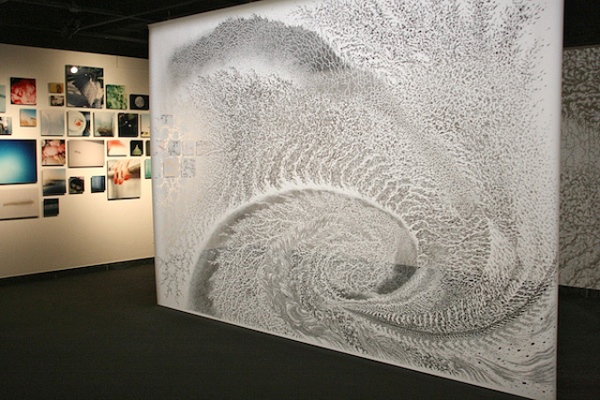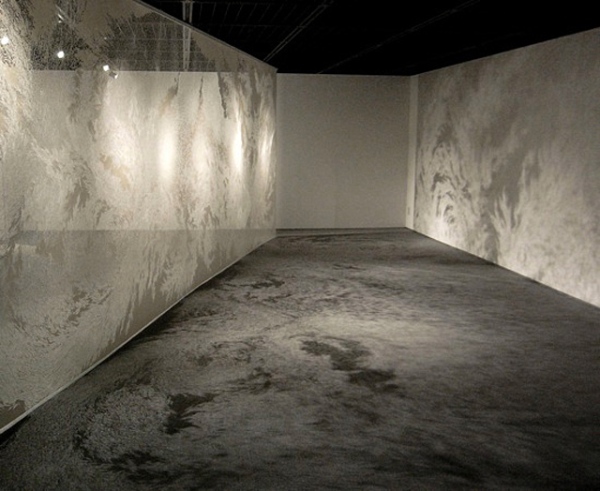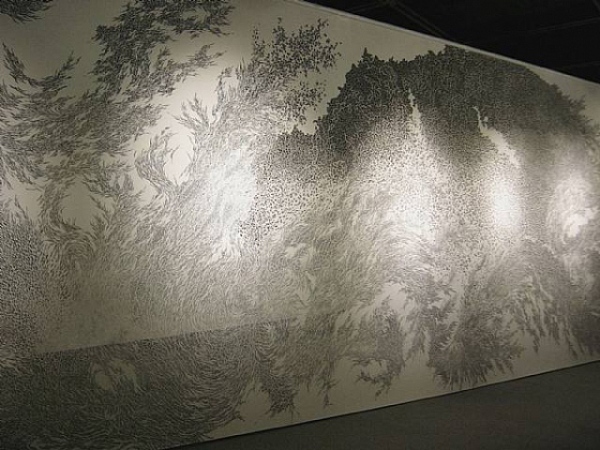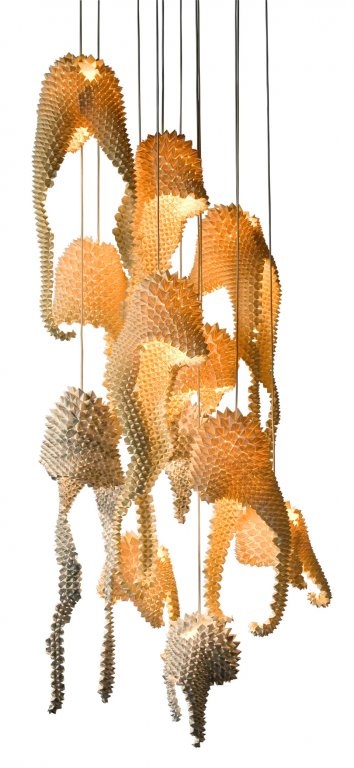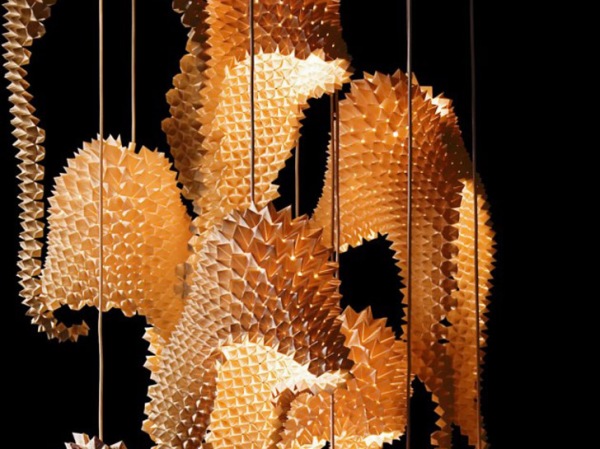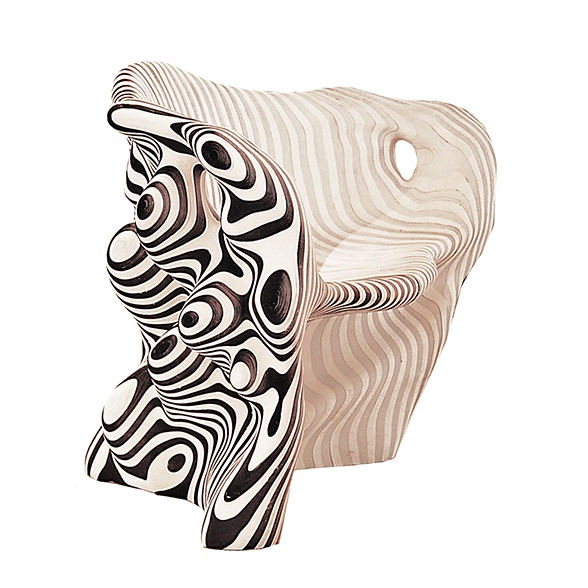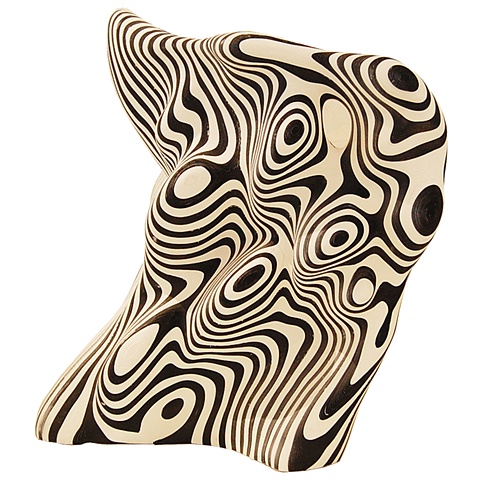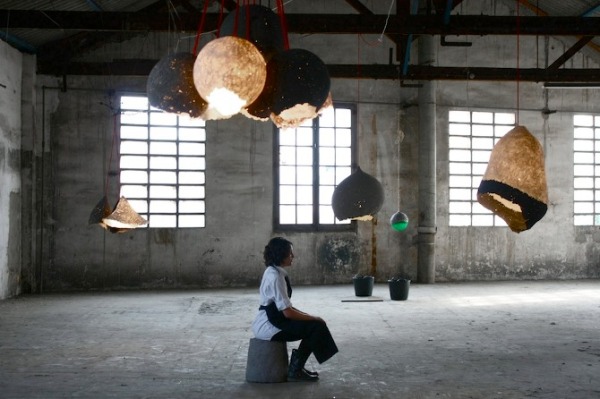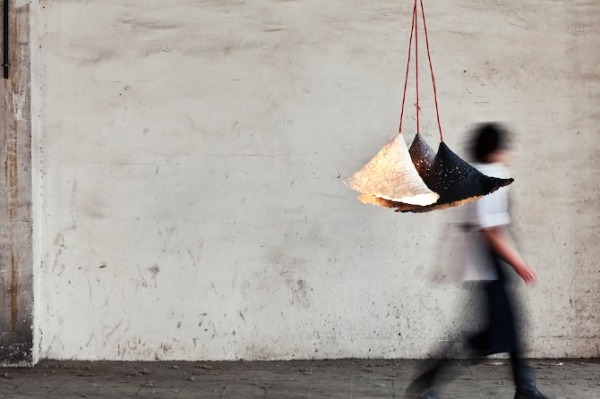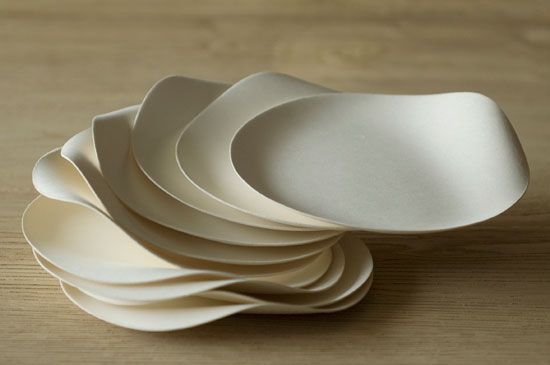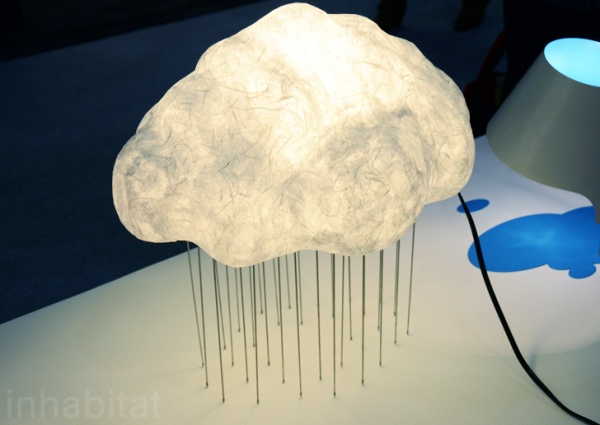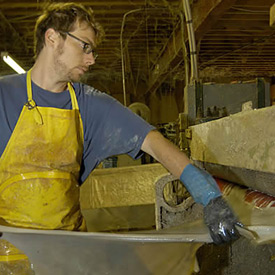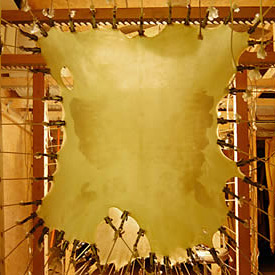Jewellery is the scale and discipline I am most accustomed to in my own making (even though I am very keen to get further into creating bigger objects) so naturally jewellery made out of paper has especially caught my attention. Here follows a section with paper jewellery I have found especially interesting. Some are found in the book Paper Jewellery/ Gioielli di Carta which is the
result of an exhibition with the same name held at the La Triennale Design Museum in Milan, Italy in 2009. One of the main themes for the exhibition and evident in many of the introductory essays is the artistic power that come with working with a non-precious material such as paper in a discipline so dictated by preciousness. It is something that I find with many of the artists work I have chosen for this section; they really have the freedom to play with the material and their artistic ideas without being too tied to tradition. Another advantage with paper is also its’ lightness allowing for quite large wearable works, but even the simple and understated can be really effective.
Inni Pärnänen’s work with parchment was one of the reasons that I started researching this topic in the first place. She has a wonderful sensitivity to materials and has done some beautiful work with paper as well.
“It is the possibilities of a material or technique that appeal to me and often start the process. The nature of the material and
the structure of the resulting piece define how my jewellery is worn.” –Inni Pärnänen[1]
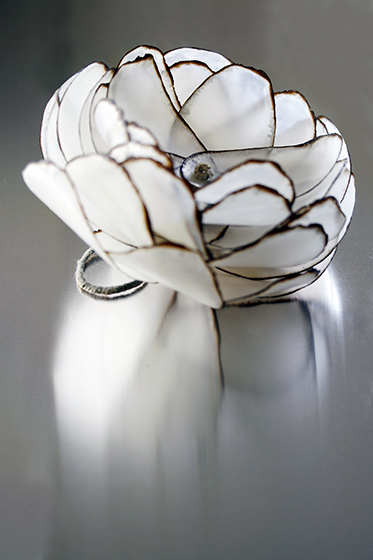
Inni Pärnänen, Ring, c2008. Burnt paper, candle wax, iron, cotton thread. Reproduced from http://www.inni.fi/gallery (accessed November 16, 2011).

Inni Pärnänen, Ordinary Beauty, c 2008. Burnt and dyed paper, candle wax iron and cotton thread. Reproduced from http://www.inni.fi/gallery (accessed November 16, 2011).

Inni Pärnänen, Body piece, c2008. Burnt and dyed paper, candle wax, iron, cotton thread. Reproduced from http://bijoucontemporain.unblog.fr/index.php?s=inni+p%E4rn%E4nen (accessed November 16, 2011).
Starting out making jewellery from recycled phone directories while a student at the University of Industrial Arts in Helsinki, Finland, to bring in a bit of extra money, Janna Syvänoja is now a well recognised paper jewellery artist[2]. She curves each piece of paper onto the steel wire at the time in a process she associates to the slow growth in nature. She is also interested in the power of jewellery serving as a form of communication between people just like the printed paper once did that is now abstracted in her jewellery.[3]

Janna Syvänoja, Necklace, 2010. Recycled paper, steel wire, 5 x 11 x 17cm. Reproduced from http://www.charonkransenarts.com/artists/syvanoja.html (accessed November 16, 2011).

Janna Syvänoja, Brooch, 2010. Recycled paper, steel wire 12 x 6 x 6 cm. Reproduced from http://www.charonkransenarts.com/artists/syvanoja.html (accessed November 16, 2011).
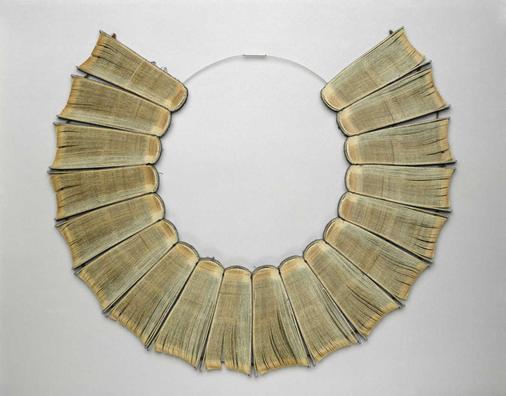
Janna Syvänoja, Necklace, 1994. Book paper, metal, cloth board, fibre cord, 3/16 x 15 inches. Reproduced from http://www.mfah.org/art/detail/finnish-necklace/ (accessed November 16, 2011).

Janna Syvänoja, Pendant, 2005.Recycled paper, steel wire, 14 x 10 x 6 cm. Reproduced from http://www.korutaideyhdistys.fi/syvanoja/index.htm (accessed November 16, 2011).

Janna Syvänoja, Brooch, 2004. Recycled paper, steel wire, 9 x 9 x 3 cm. Reproduced from http://www.korutaideyhdistys.fi/syvanoja/index.htm (accessed November 16, 2011).

Janna Syvänoja, Necklace, 2005. Recycled paper, steel wire, 20 x 4,5 cm. Reproduced from http://www.korutaideyhdistys.fi/syvanoja/index.htm (accessed November 16, 2011).
Simryn Gill is a Malaysian/Australian artist who has an ongoing project of turning the pages of books into beads by shredding and rolling, these are then strung into necklaces. Also her pieces hold a mystical power of the written word that has been abstracted. Her project with the book-pearls has been documented in a beautiful book; Pearls/ Simryn Gill, edited by Sharmini Pereira (2008).

Simryn Gill, Pearls, 1999. Reproduced from http://artblart.wordpress.com/2010/07/06/review-simryn-gill-gathering-at-heide-museum-of-modern-art-melbourne/ (accessed November 16, 2011).

Simryn Gill, Pearls, 2005. Paper, glue, hemp fiber. Reproduced from http://www.amritajhaveri.com/exhibitions/past/simryn-gill (accessed November 16, 2011).

Simryn Gill, Pearls, 2005. Paper, glue, hemp fiber. Reproduced from http://www.amritajhaveri.com/exhibitions/past/simryn-gill (accessed November 16, 2011).
Another jewellery artist that uses the technique of coiling or rolling paper into beads is German Claudia Diehl.

Claudia Diehl, Faz, 2008. Newspaper, 60 cm. Reproduced from http://www.claudia-diehl.de/galerie.htm (accessed November 16, 2011).
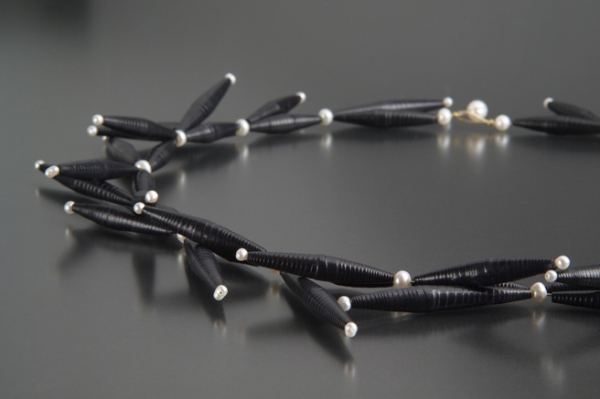
Claudia Diehl, Dornenkrone. Reproduced from http://www.claudia-diehl.de/galerie.htm (accessed November 16, 2011).

Claudia Diehl, Red. Reproduced from http://www.claudia-diehl.de/galerie.htm (accessed November 16, 2011).

Claudia Diehl, Necklace. Reproduced from http://www.stilsucht.de/10/2009/schmuck-aus-papier/ (accessed November 16, 2011).
Japanese artist Kaoru Nakano and Korean born and US trained and based jeweller Kiwon Wang both work with similar techniques of layering pieces of paper to create growing organic forms. Kiwon Wang got her MA at Rhode Island School of Design and has since then taught both there and in Korea. She speaks of her work as “’East meets West’, which is the meeting and the interplay between materials and forms, methods, techniques and literature.”[4]

Kiwon Wang, Brooch from Paper, paper series. Sterling silver, rice paper, ink, lacquer. Reproduced from http://www.kiwanwang.com/ppr_toc.html (accessed November 16, 2011).
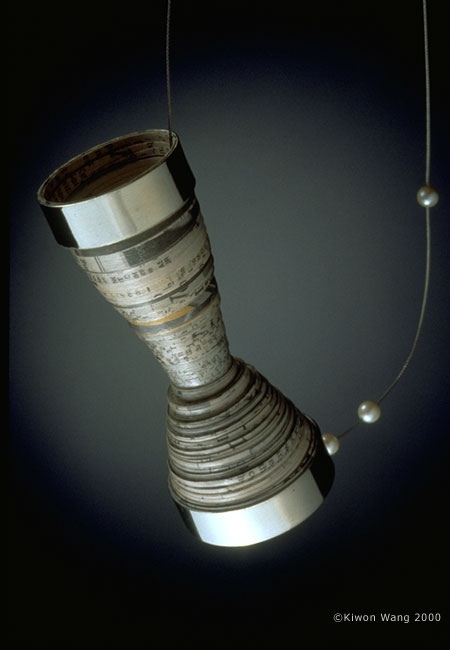
Kiwon Wang, Neckpiece from Paper, paper series. Sterling silver, pearls, newspaper, steel cable. Reproduced from http://www.kiwanwang.com/ppr_toc.html (accessed November 16, 2011).

Kiwon Wang Neckpiece from Paper, paper series. Sterling silver, newspaper. Reproduced from http://www.kiwanwang.com/ppr_toc.html (accessed November 16, 2011).

Kiwon Wang, Neckpiece from Paper, paper series. Sterling silver, newspaper. Reproduced from http://www.kiwanwang.com/ppr_toc.html (accessed November 16, 2011).
While Wang uses different types of paper and often recycled newspapers in her work, incorporating the literature, Nakano’s pieces are predominantly made from Japanese washi paper made from mulberry fibre.
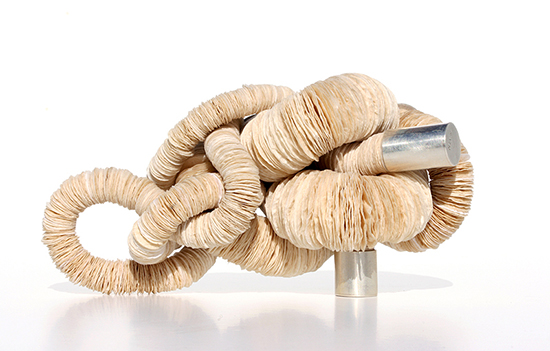
Kaoru Nakano, Untitled brooch. Japanese paper (washi), silver. Reproduced from http://www.alternatives.it/gallery/slide_designer/Nakano.html (accessed November 16, 2011).

Kaoru Nakano, Untitled Brooch. Japanese paper (washi), silver, urushi laquer. Reproduced from http://www.alternatives.it/gallery/slide_designer/Nakano.html (accessed November 16, 2011).

Kaoru Nakano, Loop & Twist brooch, 2008. Washi paper, silver, 11 x 9 x 4 cm. Reproduced from http://www.kehoe.com.au/artists/nakano-kaoru/ (accessed November 14, 2011).

Kaoru Nakano, Washi brooch. Metal, paper, 14 x 6 x 4 cm. Reproduced from http://www.kehoe.com.au/artists/nakano-kaoru/ (accessed November 14, 2011).

Kaoru Nakano, Intertwined (Red) brooch, 2009. Washi paper, silver. Reproduced from http://www.kehoe.com.au/artists/nakano-kaoru/ (accessed November 14, 2011).
Linking her use of paper as a material to the traditions of arte povera, Barcelona based contemporary jeweller Ana Hagopian says it allows for the value of the idea rather than the material and to work intuitively. It is a provocative yet humble material.[5] She employs various techniques, such as twisting, moulding, layering and folding, in creating her often colourful pieced clearly inspired by nature.
I think what all these artists have in common and what attracts me to them is an aesthetical or even outspoken reference to nature which is my greatest inspiration in my own work. But I also believe that the material lends itself quite naturally to these forms, being of nature and so closely connected with many cultures where nature has traditionally had an important influence on everyday life.
This research has made me more curious about two new materials and I feel like they could both find a way into my own studio work sometime in the near future. Keeping an open mind about different materials is very enriching in studio practice, whether you are an independent artist or a product designer for a large brand, and each material poses its own challenges and stories. I have enjoyed researching a wide range of artists working with paper and it is nice to see how it is a material than can be worked both very intuitively and conceptually. Organising the works into groups of techniques has shown that a similar technique can be used within many different disciplines of areas in art, craft and design and that the gap between art craft and design is not very big, which is encouraging as it is a gap I wish to bridge in my own practice. At the start of the project I wished to find more artists/designers/makers working with parchment and I was a little surprised at the difficulty of doing so, but as opposed to paper it is not a readily available material and only a few people still make it.
[1] http://www.inni.fi/introduction.html
(accessed October 20, 2011)
[2] http://www.nytimes.com/2009/05/02/fashion/02iht-acajshred.html
(accessed November 16, 2011)
[3] http://www.charonkransenarts.com/artists/syvanoja.html (accessed November 14, 2011)
[4] http://www.kiwanwang.com/about.html (accessed November 15, 2011)
[5] http://www.anahagopian.com/about-ana.html (accessed November 14, 2011)






